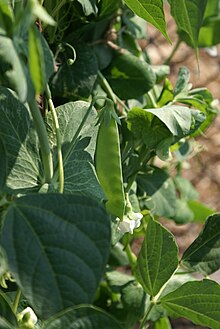Snow peas
| Snow pea | |
|---|---|
 |
|
| Snow pea on the plant | |
| Scientific classification | |
| Kingdom: | Plantae |
| (unranked): | Angiosperms |
| (unranked): | Eudicots |
| (unranked): | Rosids |
| Order: | Fabales |
| Family: |
Fabaceae Lindl. |
| Subfamily: | Faboideae |
| Genus: | Pisum |
| Species: | Pisum sativum |
| Variety: | P. sativum var. saccharatum |
| Trinomial name | |
|
Pisum sativum var. saccharatum |
|
|
Snow peas (Pisum sativum)
|
|
| Nutritional value per 100g | |
|---|---|
| Energy | 176 kJ (42 kcal) |
|
7.55
|
|
| Sugars | 4.00 |
| Dietary fiber | 2.6 |
|
0.2
|
|
|
2.8
|
|
| Vitamins | |
| Vitamin A equiv. |
(6%)
630 μg740 μg
|
| Vitamin A | 1087 IU |
| Thiamine (B1) |
(13%)
0.150 mg |
| Riboflavin (B2) |
(7%)
0.08 mg |
| Niacin (B3) |
(4%)
0.6 mg |
| Pantothenic acid (B5) |
(15%)
0.75 mg |
| Vitamin B6 |
(12%)
0.16 mg |
| Folate (B9) |
(11%)
42 μg |
| Vitamin B12 |
(0%)
0 μg |
| Choline |
(4%)
17.4 mg |
| Vitamin C |
(72%)
60 mg |
| Vitamin D |
(0%)
0 μg |
| Vitamin E |
(3%)
0.39 mg |
| Vitamin K |
(24%)
25 μg |
| Minerals | |
| Calcium |
(4%)
43 mg |
| Iron |
(16%)
2.08 mg |
| Magnesium |
(7%)
24 mg |
| Manganese |
(12%)
0.244 mg |
| Phosphorus |
(8%)
53 mg |
| Potassium |
(4%)
200 mg |
| Sodium |
(0%)
4 mg |
| Zinc |
(3%)
0.27 mg |
| Other constituents | |
| Water | 88.89 |
|
|
| Percentages are roughly approximated using US recommendations for adults. Source: USDA Nutrient Database |
|
The snow pea (Pisum sativum var. saccharatum) is a legume, more specifically a variety of pea eaten whole in its pod while still unripe. The name mangetout (French for “eat all”) can apply both to snow peas and to snap peas.
Snow peas, along with sugar snap peas and unlike field and garden peas, are notable for having edible pods that lack inedible fiber (in the form of "parchment", a fibrous layer found in the inner pod rich in lignin) in the pod walls. Snow peas have the thinner walls of the two edible pod variants. Two recessive genes known as p and v are responsible for this trait.p is responsible for reducing the schlerenchymatous membrane on the inner pod wall, while v reduces pod wall thickness (n is a gene that thickens pod walls in snap peas).
The stems and leaves of the immature plant are used as a vegetable in Chinese cooking, stir-fried with garlic and sometimes combined with crab or other shellfish.
As with most legumes, snow peas host beneficial bacteria, rhizobia, in their root nodules, which fix nitrogen in the soil—this is called a mutualistic relationship—and are therefore a useful companion plant, especially useful to grow intercropped with green, leafy vegetables that benefit from high nitrogen content in their soil.
Snow peas can be grown in open fields during cool seasons and can thus be cultivated during winter and spring seasons.
Storage of the pea with films of polymethylpentene at a temperature of 5°C and a concentration of oxygen and carbon dioxide of 5 kPa augments the shelf life, internal and external characteristics of the plant.
...
Wikipedia

